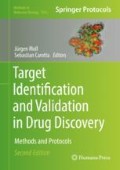Abstract
Pooled genetic screens are a powerful tool to identify targets for drug development as well as chemogenetic interactions. Various complementary methods for mutagenesis are available to generate highly complex cell populations, including mRNA knockdown, directed genome editing, as well as random genome mutagenesis. With the availability of a growing number of haploid mammalian cell lines, random mutagenesis is becoming increasingly powerful and represents an attractive alternative, e.g., to CRISPR-based screening. This chapter provides a step-by-step protocol for performing haploid gene trap screens.
Access this chapter
Tax calculation will be finalised at checkout
Purchases are for personal use only
References
Hoepfner D, Helliwell SB, Sadlish H et al (2014) High-resolution chemical dissection of a model eukaryote reveals targets, pathways and gene functions. Microbiol Res 169:107–120. https://doi.org/10.1016/j.micres.2013.11.004
Forsburg SL (2001) The art and design of genetic screens: yeast. Nat Rev Genet 2:659–668. https://doi.org/10.1038/35088500
Hartwell LH, Culotti J, Pringle JR, Reid BJ (1974) Genetic control of the cell division cycle in yeast. Science 183:46–51. https://doi.org/10.1126/science.183.4120.46
Pris J, Clement D, Kessous A, Colombies P (1980) Near haploid cell line in lymphoid blast crisis of ph1-positive chronic myeloid leukemia. Cancer Res 40:1354–1359
Brodeur G, Williams D, Look A et al (1981) Near-haploid acute lymphoblastic leukemia: a unique subgroup with a poor prognosis. Blood 58:14–19
Kotecki M (1999) Isolation and characterization of a near-haploid human cell line. Exp Cell Res 252:273–280. https://doi.org/10.1006/excr.1999.4656
Carette JE, Guimaraes CP, Varadarajan M et al (2009) Haploid genetic screens in human cells identify host factors used by pathogens. Science 326:1231–1235. https://doi.org/10.1126/science.1178955
Carette JE, Pruszak J, Varadarajan M et al (2010) Generation of iPSCs from cultured human malignant cells. Blood 115:4039–4042. https://doi.org/10.1182/blood-2009-07-231845
Carette JE, Raaben M, Wong AC et al (2011) Ebola virus entry requires the cholesterol transporter Niemann-Pick C1. Nature 477:340–343. https://doi.org/10.1038/nature10348
Carette JE, Guimaraes CP, Wuethrich I et al (2011) Global gene disruption in human cells to assign genes to phenotypes by deep sequencing. Nat Biotechnol 29:542–546. https://doi.org/10.1038/nbt.1857
Perrot V, Richerd S, Valéro M (1991) Transition from haploidy to diploidy. Nature 351:315–317. https://doi.org/10.1038/351315a0
Freed JJ, Mezger-Freed L (1970) Stable haploid cultured cell lines from frog embryos. Proc Natl Acad Sci U S A 65:337–344. https://doi.org/10.1073/pnas.65.2.337
Yi M, Hong N, Hong Y (2009) Generation of medaka fish haploid embryonic stem cells. Science 326:430–433. https://doi.org/10.1126/science.1175151
Elling U, Taubenschmid J, Wirnsberger G et al (2011) Forward and reverse genetics through derivation of haploid mouse embryonic stem cells. Cell Stem Cell 9:563–574. https://doi.org/10.1016/j.stem.2011.10.012
Leeb M, Wutz A (2011) Derivation of haploid embryonic stem cells from mouse embryos. Nature 479:131–134. https://doi.org/10.1038/nature10448
Li W, Shuai L, Wan H et al (2012) Androgenetic haploid embryonic stem cells produce live transgenic mice. Nature 490:407–411. https://doi.org/10.1038/nature11435
Yang H, Shi L, Wang BA et al (2012) Generation of genetically modified mice by oocyte injection of androgenetic haploid embryonic stem cells. Cell 149:605–617. https://doi.org/10.1016/j.cell.2012.04.002
Li W, Li X, Li T et al (2014) Genetic modification and screening in rat using haploid embryonic stem cells. Cell Stem Cell 14:404–414. https://doi.org/10.1016/j.stem.2013.11.016
Yang H, Liu Z, Ma Y et al (2013) Generation of haploid embryonic stem cells from Macaca fascicularis monkey parthenotes. Cell Res 23:1187–1200. https://doi.org/10.1038/cr.2013.93
Sagi I, Chia G, Golan-Lev T et al (2016) Derivation and differentiation of haploid human embryonic stem cells. Nature 532:107–111. https://doi.org/10.1038/nature17408
Zhong C, Zhang M, Yin Q et al (2016) Generation of human haploid embryonic stem cells from parthenogenetic embryos obtained by microsurgical removal of male pronucleus. Cell Res 26:743–746
Wang H, Zhang W, Yu J et al (2018) Genetic screening and multipotency in rhesus monkey haploid neural progenitor cells. Development 145. pii: dev160531. https://doi.org/10.1242/dev.160531
Elling U, Wimmer RA, Leibbrandt A et al (2017) A reversible haploid mouse embryonic stem cell biobank resource for functional genomics. Nature 550:114–118. https://doi.org/10.1038/nature24027
Elling U, Penninger JM (2014) Genome wide functional genetics in haploid cells. FEBS Lett 588:2415. https://doi.org/10.1016/j.febslet.2014.06.032
Schnütgen F, Hansen J, De-Zolt S et al (2008) Enhanced gene trapping in mouse embryonic stem cells. Nucleic Acids Res 36:e133. https://doi.org/10.1093/nar/gkn603
Horn M, Kroef V, Allmeroth K et al (2018) Unbiased compound-protein interface mapping and prediction of chemoresistance loci through forward genetics in haploid stem cells. Oncotarget. https://doi.org/10.18632/oncotarget.24305
Schmidt M, Schwarzwaelder K, Bartholomae C et al (2007) High-resolution insertion-site analysis by linear amplification-mediated PCR (LAM-PCR). Nat Methods 4:1051–1057. https://doi.org/10.1038/nmeth1103
Potter CJ, Luo L (2010) Splinkerette PCR for mapping transposable elements in Drosophila. PLoS One 5:e10168. https://doi.org/10.1371/journal.pone.0010168
Ochman H, Gerber AS, Hartl DL (1988) Genetic applications of an inverse polymerase chain reaction. Genetics 120:621–623
Author information
Authors and Affiliations
Corresponding author
Editor information
Editors and Affiliations
Rights and permissions
Copyright information
© 2019 Springer Science+Business Media, LLC, part of Springer Nature
About this protocol
Cite this protocol
Volz, J.C., Schuller, N., Elling, U. (2019). Using Functional Genetics in Haploid Cells for Drug Target Identification. In: Moll, J., Carotta, S. (eds) Target Identification and Validation in Drug Discovery. Methods in Molecular Biology, vol 1953. Humana Press, New York, NY. https://doi.org/10.1007/978-1-4939-9145-7_1
Download citation
DOI: https://doi.org/10.1007/978-1-4939-9145-7_1
Published:
Publisher Name: Humana Press, New York, NY
Print ISBN: 978-1-4939-9144-0
Online ISBN: 978-1-4939-9145-7
eBook Packages: Springer Protocols

